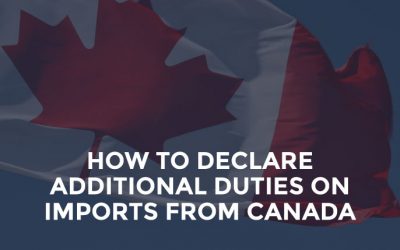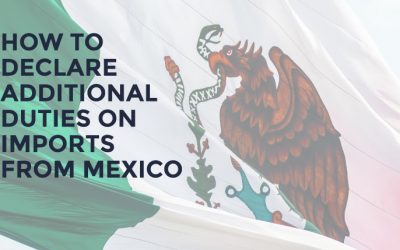Within the history of anti-dumping and countervailing duties in the United States is an interesting look at the history of international trade.
There has been a lot of talk about Anti-dumping and Countervailing duties in the news lately, but where did they come from? We are going to dive into the history of anti-dumping and countervailing in the United States and how these duties have been created through the years.
The History of Anti-dumping and Countervailing Begins in the United States
- Sherman Antitrust Act of 1890
The history of U.S. anti-dumping and countervailing truly begins with concerns about fair competition fostering monopolies with the Sherman Antitrust Act of 1890 declaring “any effort to combine or conspire to monopolize a particular market” illegal. This law tries to prevent the artificial raising of prices by restriction of trade or supply while allowing monopolies achieved solely by merit (innocent monopolies) to still thrive. - Clayton Act of 1914
The Sherman Antitrust Act was later reinforced by the Clayton Act of 1914 which made “price discrimination an illegal practice if it reduced competition or tended to create a monopoly”. - Antidumping Act of 1916
These two pieces of legislation entered the world of international trade with the Antidumping Act of 1916 which was a part of the Revenue Act of 1916. This act made it illegal to sell imported goods at prices substantially lower than the market value in the exporting country “…with the intent of destroying or injuring an industry in the United States, or of prevent the establishment of an industry in the United States, or of restraining or monopolizing any part of trade and commerce in such articles in the United States.”This act was a criminal statute which means that it was enforced through criminal punishments. Instead of a higher duty rate, those found guilty faced possible imprisonment.
The Modern History of Anti-dumping and Countervailing Law
- Antidumping Act of 1921
It wasn’t until the Antidumping Act of 1921 that modern U.S. anti-dumping law emerged in the capacity that it is recognized today. This act states the following:“Whenever the Secretary of the Treasury finds that an industry in the United States is likely to be injured, or is prevented from being established, by reason of the importation into the United States of foreign merchandise, and that merchandise of such class or kind is being sold or is likely to be sold in the United States or elsewhere at less than its fair value, he shall make such finding public. . . . [I]f the purchase price or the exporter’s sales price is less than the foreign market value (or, in the absence of such value, than the cost of production), there shall be levied, collected, and paid a special dumping duty in an amount equal to such difference.”
This act contains the most recognizable elements that make up the current definition of antidumping and countervailing. Unlike the Antidumping Act of 1916 which put the focus on the exporter’s intent, this act put the focus on finding price discrimination and injury and resulted in higher import duties as opposed to criminal charges.
- Tariff Act of 1930
The Tariff Act of 1930 is more commonly referred to as the Smoot-Hawley Tariff Act which raised import duties to protect American businesses and farmers. This act defined anti-dumping and countervailing duties under Subtitle IV and, as part of the Tariff Act of 1930, any U.S. industry can petition the government for relief from goods they consider being sold at less than fair market value. This act also authorized the investigation, by the United States government, of unfair competition related to these imports. - General Agreement on Tariffs and Trade (GATT 1947)
In 1947 the World Trade Organization (WTO) and the United Nations came together at the conference on Trade and Employment and created the General Agreement on Tariffs and Trade, also known as GATT 1947. Part of this agreement was Article 6 and it was based on the U.S. Anti-dumping Act of 1921 but incorporated a world perspective to keep the world, globally, on the same page with anti-dumping and countervailing. - Trade Act of 1974
Major changes to the legislature on anti-dumping and countervailing occurred once again with the Trade Act of 1974. This act expanded the definition of ‘dumping’ to include home market sales below the average cost of production. - Trade Agreements Act of 1979
Five years later, the Trade Agreements Act of 1979 made the biggest changes overall and is established how the legislation works today. This act repealed the Anti-dumping Act of 1921 and it also revised the law enacted as Title VII of the Tariff Act of 1930. Ultimately, it shortened time limits on dumping and subsidized export investigations and allowed the use of “best information available” when foreign firms did not provide requested information. - The Trade and Tariff Act of 1984
This act made is so that the International Trade Commission is required to gather the imports of all countries
subject to an antidumping investigation when making an injury determination. Ultimately this increased the benefit domestic firms gain by filing petitions targeting several different countries of dumping the same product.
After considering this timeline, the deep roots the history of anti-dumping and countervailing have in the United States becomes apparent. Regardless of the amount of attention the topic receives or doesn’t receive in the current news stream, the legislation behind protecting the United States market is not going anywhere.
For a more information on anti-dumping and countervailing, watch our previous webinars on the topic: The Basics of Antidumping and Countervailing and Mitigate the Risks of Anti-Dumping and Countervailing.
Source: THE RISE OF U.S. ANTIDUMPING ACTIONS IN HISTORICAL PERSPECTIVE – Douglas Irwin





![[Webinar] How Could Changes to De Minimis Impact Your Company?](https://traderiskguaranty.com/trgpeak/wp-content/uploads/2025/05/trg-how-de-minimis-impacts-customs-bond-webinar-400x250.png)

